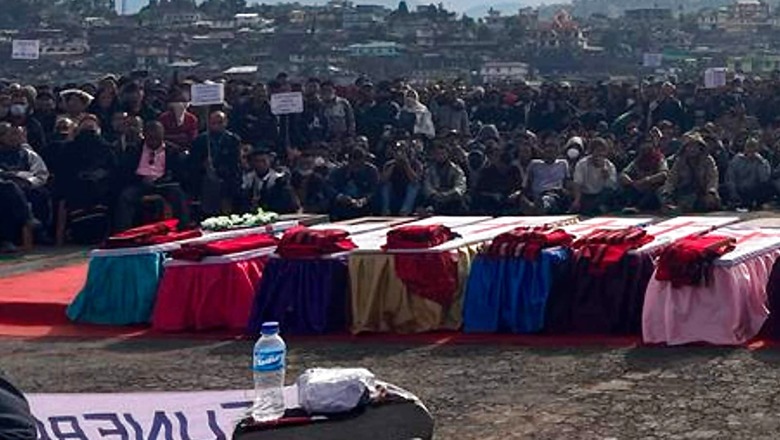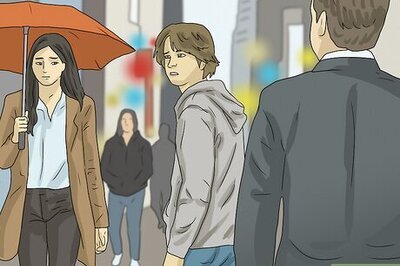
views
After the killing of 14 innocent Konyak civilians by 21 special para commando force last week in Oting village of Mon district of Nagaland, little is known about Nagaland, its history, culture, freedom movement, and the tribe.
The Konyak is the largest tribe, followed by Ao, Tangkhul, Sema, and Angami in Nagaland. Other Naga tribes include Lotha, Sangtam, Phom, Chang, Khiemnungam, Yimchungre, Zeliang, Chakhesang (Chokri), and Rengma.
All the 14 Konyaks were returning from coal mines to their home in Oting village on December 4. On their way, 21 special para commando force allegedly fired on the innocent Konyak coal labours suspecting them to be insurgents.
Konyaks live in Mon district of Nagaland, Tirap, Longding, and Changlang districts of Arunachal Pradesh; Sibsagar District of Assam; and also in Myanmar. They are known in Arunachal Pradesh as the Wanchos (‘Wancho’ is a synonymous term for ‘Konyak’). Ethnically, culturally, and linguistically the Noctes and Tangsa of the same neighbouring state of Arunachal Pradesh, are also closely related to the Konyaks.
In the past, the Konyaks were famous for their practice of head hunting. A rite of passage for young boys of the tribe was to present the decapitated heads of the rival tribe members into the community. And this resulted in their community being mostly isolated. The decapitated heads were brought back as trophies and hung in a community barn known as a “baan”. The number of heads decapitated was directly proportional to the honor and the position of the warrior in the society. The expeditions of head-hunting were founded on traditional codes of honor, principles of loyalty and certain beliefs about sacrifice that one had to make. The tribe maintained a strict code of discipline for everyone to abide by. They were expected to fulfill their given responsibilities and adhere to the duties assigned to them.
But this began to change under the rule of the British. They looked beyond the tea estates of Assam and in 1870s sent about missionaries to the land of the Nagas to mould them into western standards of civilization. Many Naga tribes converted to Christianity in lieu of free education, food and shelter, the Konyaks were the last to approve of this change being brought about in their land.
Konyak Tradition
The term ‘Konyak’ is believed to have been derived from the words ‘Whao’ meaning ‘head’ and ‘Nyak’ meaning ‘black’ translating to ‘men with black hair’. They can be grouped into two groups, namely ‘Thendu’, which means the ‘Tattooed Face’ and ‘Thentho’, meaning the ‘White face’. The Thendu group is mostly found in the central part of Mon district and Thentho group mostly in the upper part and in the lower part of the district in Wakching area.
Linguistically, the Konyaks come under the Naga-Kuki group of Tibeto-Burman family with each village having its own dialect. The dialect of the Wakching village is commonly used as the medium of communication.
A unique feature of the Konyak tradition is the practice of the Angh (king) system. There are two different kinds of Anghs among the Konyaks, Pongyin Angh or Anaghtak Anghyong (the Great King or Chief) and Anghha (small king).
The Pongyin Angh is found only in some Thendu villages. In a village where there is no Pongyin Angh, an Anghha is appointed. Such a village becomes a subject village to the Pongyin Angh from whose family the Anghha is appointed. The Anghha and the village council consisting of an elder from nokphong (clan) take care of the village administration.
Altogether, there are seven “Chief Anghs” within Mon District, namely Mon, Chui, Shengha Chingnyu, Longwa, Shangnyu, Jaboka and Tangnyu. The Chief Anghs of these villages rule over a group of satellite villages under them, some of which are in Arunachal Pradesh and in Myanmar but have strong customary and traditional relationship with the rest villages in Mon District.
Konyak village is divided into different sections called the Baan (pronounced Paan). The baan is like the ‘Morung’ of the other Naga tribes. The term Baan is also used to denote the traditional institution of learning young men learnt the war-skill, traditional arts and crafts, hunting, folk dances and songs, wrestling and other traditional games and sports. It also served as a centre for religious and social activities. Another place Ywo was also a centre of learning for women. But, now the Ywo and Baan system are almost non-existent.
Skills and Festivals
Festivals occupy an importance place in the lives of the Konyaks. The three most significant festivals were Aolingmonyu, Aonyimo and Laoun-ongmo. Aolingmonyu is celebrated in the first week of April after sowing of seeds, and this marks the beginning of a new year. Its religious significance is to appease God for a prosperous harvest. The Aonyimo is celebrated in July or August after the harvest of the first crops such as maize and vegetables. The Laoun-ongmo is thanks-giving festival and is celebrated after all agricultural activities are completed.
The Konyaks are skilled in the art of making firearms. They are also skilled in handicrafts such as basket making, cane and bamboo and brass works. Shangnyu and Chui have been declared as ethnic villages providing a rich educational research work for anthropologists.
Traditional Attire
In the past, it is believed that the Konyak men wore absolutely nothing except a bare apron that covered their private parts even the women were known to wear only a 10-inch-long skirt to cover their bottom. Instead of clothes they adorned and covered themselves with ornaments such as head gears, armlets, necklaces, earrings, bracelets, cane leggings and more such accessories.
In the modern times, the Konyak men dress themselves with a sash about 10 inches long around their chest, which has a special pattern embroidered to it along with a long apron that covers their private parts along with exquisite and extravagant adorations on their bodies.
The Konyak women wear a sleeveless blouse along with a long wrap around skirt that reaches 5 inches below the knees along with grand ornaments to adorn their necks and heads.
The Konyaks are hospitable in nature, warm hearted and fond of merry-making. Elderly men indulge themselves with “Khalap” which is black tea and a kettle is always left in the fireplace for boiling black tea.
What Do They Eat?
Pork and Mithun meat are extremely enjoyed by Konyaks along with rice and other leafy vegetables. The Konyaks prefer to eat many kinds of meats and root and leafy vegetables.
Faith and Religion
The Konyaks believed in their own religion that they are all Longjing Pesao Te Khiimpu. A konyak scholar who would be called a Yanang would call his tribe religion to be Animism. They believed in the spirits and the energies that made the world go round.
The History of Mon District
Covering an area of 1,786 square kilometres, Mon district is bounded in the North by Sibsagar district of Assam, Arunachal Pradesh in the northeast, Myanmar in southeast and Tuensang and Longleng districts of Nagaland in the south. Mon is the third biggest district representing 10.77% of the total area of Nagaland.
The area, which is known as Mon District and located in the northeastern part of Nagaland, was not brought under the Civil Administration till 1948. Even in the beginning of the 19th Century, a vast tract of land lying between the administered areas of Assam and Myanmar was not brought under the Civil Administration by the British.
By 1914, the Foreign and Political Department of the Government of India, by a Notification, extended the Assam Frontier Tract Regulation (AFTR) of 1880 to the Hills, which were either inhabited or frequented by Abors, Mishmis, Singphos, Nagas, Khamtis, Bhutias, Akas and Daflas. It is by this extension of the aforesaid Regulation, the Government of India brought the area under some administration in 1914 and the area was named as the North East Frontier Tract. Hence, the present Mon district was also brought under same Notification but practically, there was no Civil Administration till 1948.
In 1951, the plains portion of Balipara Frontier Tract, Tirap Frontier Tract, Abor Hills District and Mishmi Hills were transferred to the administrative jurisdiction of the Government of Assam. Thereafter, the remaining areas of the said North East Frontier together with the Naga Tribal Area of Tuensang including the present Mon were re-named as the North East Frontier Agency (NEFA). The Mon Sub-division under the Tuensang Frontier Division was created and the officer who was first posted, as the Assistant Political Officer was WH Rynjah.
The district was carved out of the Tuensang district on December 21, 1973. The district was enlarged in 1991 by transferring some villages from the Tuensang district and creating some new administrative circle headquarters at Tobu (head by the Additional Deputy Commissioner), Mopong and Muknyakshu (headed by the Extra Assistant Commissioner each).
The Mon district can be divided into two regions topographically, namely the upper region and lower region. The upper region comprising Longching, Chen, Mopong and Tobu areas and the lower region comprises Mon, Tizit and Naginimora area. The foothills lie adjacent to the plains of Assam, the Tizit and Naginimora areas. The hill ranges extend from the foothills to the slopes of Naga Hills and Patkai Range in the Eastern side of the district.
According to 2021 census, the district has 131 villages and two statutory towns viz., Mon Town and Naginimora Town. It has a total of 14 Subdivisions.
As per census report, Mon district has a population of 262,222 with the density of population (Persons per sq KM) at 140. The overall Sex Ratio Total (Number of females per 1000 males) was at 899. The overall literacy rate stood at 56.99% with 60.94% male and 52.58% female.
Read all the Latest India News here

















Comments
0 comment